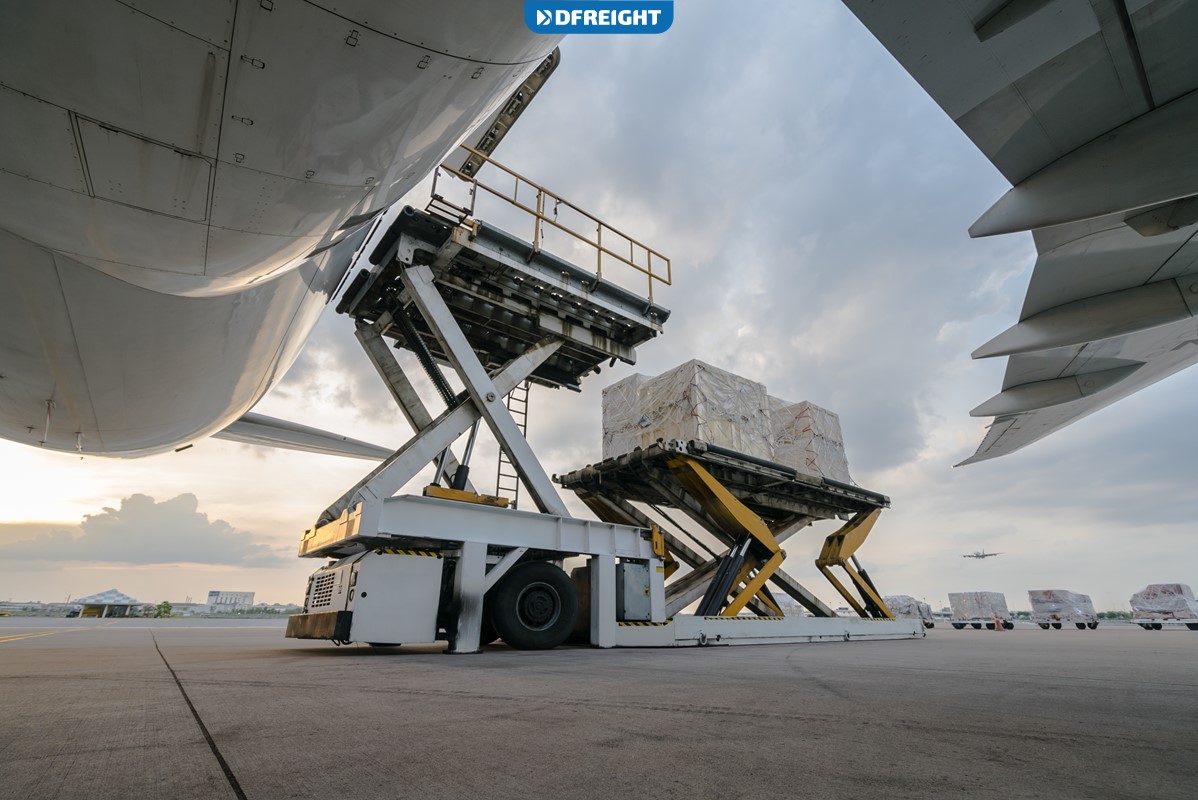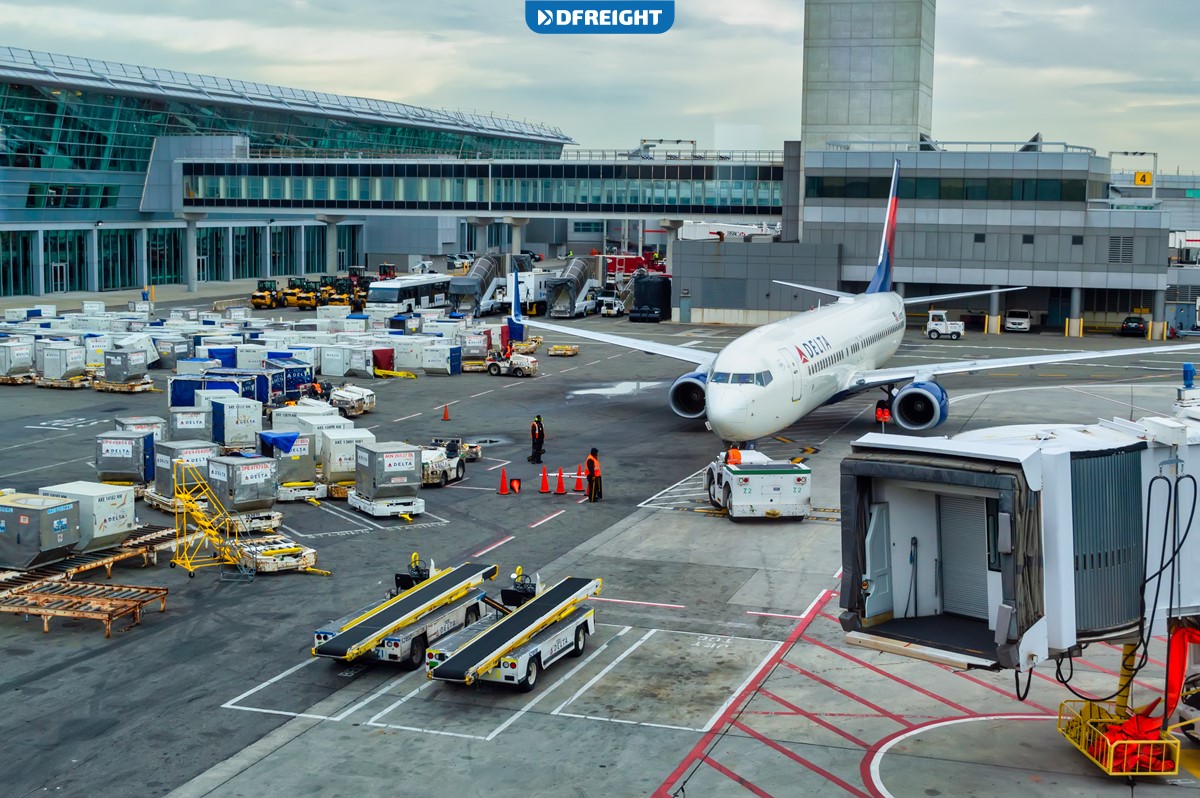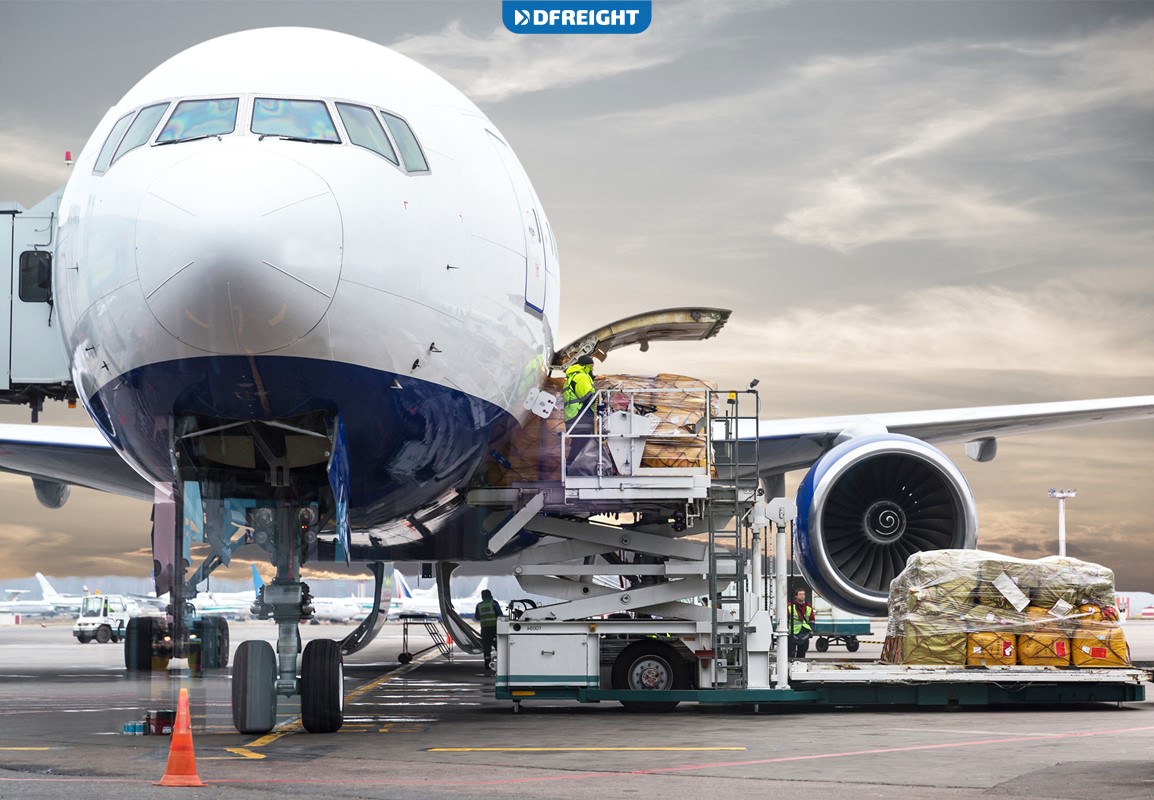Cargo flights contribute significantly to the transportation of various types of cargo worldwide. Many commodities, including temperature-sensitive products, electronics, pharmaceuticals, auto parts, machinery, and weapons, are shipped by cargo aircraft daily. However, many businesses find it challenging to book a cargo flight in advance properly.
To help you face the challenge as easy as possible, this blog post gives you an overview of cargo flights, their history, benefits, risks, and challenges, as well as a step-by-step guide to booking a cargo flight today. If you need more information on air freight, don’t hesitate to contact our professionals at DFfreight. We’ll be more than happy to assist you all along the way.
Table of Contents
What Is a Cargo Flight?
A cargo flight is a flight used to transport goods rather than passengers. These flights are typically operated by airlines or freight companies, and they use specialized aircraft designed to carry large amounts of cargo. Cargo flights usually operate between airports with facilities for handling cargo and often use dedicated cargo terminals. Most cargo flights are scheduled flights, but there is also a growing market for ad-hoc cargo flights operated on an as-needed basis.
Cargo Flights vs. Passenger Flights
The main difference between passenger and cargo flights is the type of aircraft used. Cargo aircraft are designed to carry large loads of cargo, while passenger aircraft are designed to carry people and have a smaller cargo capacity.
Freight aircraft are typically larger than passenger aircraft and have a higher payload capacity. They also have a larger cargo door for loading and unloading cargo. Passenger aircraft usually have a cabin that is divided into sections for different classes of passengers. First class passengers have more legroom and larger seats than economy class passengers.
Cargo aircraft typically fly at a lower altitude than passenger aircraft because they are not as concerned about turbulence. They also have a higher cruising speed because they are not carrying as many people.
The History of Cargo Flights

Cargo flights have a long history, dating back to the early days of aviation. One of the first cargo flights took place in 1910 when a French pilot flew a load of silk from France to China.
In the 1920s, cargo flights became more common as airlines began transporting mail and other goods worldwide.
During World War II, cargo flights were vital in transporting supplies and equipment to troops overseas. Cargo planes were also used to transport food and other supplies to areas affected by the war.
In the 1950s and 1960s, the development of jet engines and larger aircraft allowed for even more cargo to be transported by air.
Today, cargo flights are essential to the global economy, transporting everything from clothes and food to electronics and car parts.
Benefits of Cargo Flights
Cargo flights are vital to the aviation industry, as they transport goods and materials worldwide. They are typically operated by larger aircraft, such as the Boeing 747-400F and Airbus A380-800F, designed to carry large amounts of cargo. Cargo flights are essential for businesses and industries that rely on transporting goods, as they allow for the quick and efficient movement of products.
Here are the key benefits of cargo flights for transporting freight worldwide:
- Cargo flights provide a critical link in the global supply chain management, ensuring that goods and materials can be transported quickly and efficiently to where they are needed.
- Cargo flights can carry various goods, from food and medical equipment to manufacturing parts and construction materials.
- Cargo flights can operate to and from a wide range of airports, including those in remote and underserved areas.
- Cargo flights can help reduce congestion at busy airports and provide a significant economic boost to local communities.
- Cargo flights can be more environmentally friendly than ground transport, as they can use existing infrastructure and fuel resources.
The Risks and Challenges of Cargo Flights

Cargo flights are an essential part of the global economy, transporting goods and materials worldwide. However, they can also be risky, carrying large loads of dangerous goods and explosive materials.
A cargo plane crash in 2010 near Bagram Air Base in Afghanistan killed seven people and destroyed more than $100 million worth of equipment. The crash highlighted the dangers of carrying cargo on military aircraft, which are not subject to the same safety regulations as commercial planes.
In 2013, a UPS cargo plane crashed in Birmingham, Alabama, killing two pilots and injuring two others. The cause of the crash was determined to be pilot error, but investigators also found that the plane was carrying a large load of highly flammable lithium batteries, which may have contributed to the fire that broke out after the crash.
Cargo planes are also sometimes used to transport illegal drugs and other contraband. In 2006, a FedEx plane carrying a shipment of illegal cigarettes was intercepted by authorities in the United Kingdom. And in 2010, a UPS plane carrying a shipment of marijuana was intercepted by authorities in the United States.
The risks associated with cargo flights are real but also manageable. By following safety regulations and using proper packaging and labeling, shippers can help ensure that their shipments arrive safely at their destination.
What to Consider When Booking a Cargo Flight
When booking a cargo flight, there are a few things to consider to ensure your shipment arrives safely and on time. First, you’ll need to determine the size and weight of your shipment, as this will determine the type of aircraft that can be used. Next, you’ll need to choose a reputable and experienced cargo airline, as not all airlines have the same capabilities. You’ll also need to determine your shipment’s route, as some routes are more direct than others. Finally, you’ll need to consider the cost of the shipment, as cargo rates can vary depending on the airline, route, and other factors.
A Step-by-Step Guide to Book a Cargo Flight

Booking shipments for transportation by air requires a drawn-out procedure that starts with shipment preparation and finishes with the cargo’s arrival at its destination. In the details provided below, you may find further information about how to book a cargo flight.
1. Look for Limitations: Reviewing the limitations and constraints that are in place for safety, and other reasons come first when booking a cargo flight. For reserving cargo on a flight, the airlines place a number of limitations that may differ slightly. You must always check if any item of your shipment is included in the list of restricted or prohibited items.
2. Select the Products and Services: Based on the factors that are most important to you, you should decide which product and service category will best satisfy your needs after comprehending the limits.
3. Make a Reservation: You must reserve a space on the flight in advance by calling the airline’s reservations office to ensure that your cargo gets transported.
4. Prepare Your Documents and Cargo: Consult the airline’s container standards to learn how to prepare your cargo for air flights properly. Next, pack your cargo securely for air shipping and label it with the consignee’s address, item count, and AWB number. Complete all required documents, including AWBs, certifications, and declarations, which must be delivered together with the shipment.
5. Complete the Air Waybill: The next step is to complete the Air Waybill, a document required to move cargo abroad that is often done on behalf of the shipper by a transporter. It includes documentation for the Contract of Carriage, evidence of the shipment of the goods, a freight bill, and instructions for packing, dispatching, and conveying the cargo.
6. Drop the Cargo, and Keep Tracking: Once preparing all of the cargo and paperwork have been completed, you must be prepared to transport everything to the location of acceptance and drop it off. Please remember that the mentioned times for cargo drop-off depend on your consignment being approved for transport. After that, you can monitor the status of your shipment from pickup to delivery using the online cargo tracking system.
7. Cargo Collection: Collection at the destination is the last step in the cargo transportation procedure. How long it takes to get your package depends on its available goods and services.
Many airlines offer cargo flights, allowing you to quickly and safely carry your merchandise from one place to another. If you need assistance with a cargo booking, you can also get in touch with your freight forwarder and ask for help.
Final Words
Cargo flights play an essential role in the global economy, transporting goods and materials all around the world. However, they can also be risky, carrying large loads of dangerous and flammable materials. By following safety regulations and using proper packaging and labeling, shippers can help ensure that their shipments arrive safely at their destination.
If you’re looking for a reliable freight forwarder in the UAE to transport your cargo internationally by air, trust DFreight’s Air Freight service. We help you transport your cargo to its destination quickly and reliably, at highly competitive rates, when time is of the essence for your time-sensitive shipment. Call us today!
FAQs
What is a cargo flight?
A cargo flight is a flight that is used to transport goods, rather than passengers. Cargo flights are typically operated by airlines or freight companies, and they use specialized aircraft that have been designed to carry large amounts of cargo.
What are the benefits of cargo flights?
Cargo flights provide a critical link in the global supply chain, ensuring that goods and materials can be transported quickly and efficiently to where they are needed. They can carry various goods, operate to and from a wide range of airports, help reduce congestion at busy airports and be more environmentally friendly than ground transport.
How can I book a cargo flight?
First, check for restrictions, then decide which product and service category will best satisfy your needs, reserve a space on the flight in advance, prepare your documents and cargo, complete the Air Waybill, and finally, drop the cargo, and keep tracking.
What makes DFreight Air Freight Service different from other freight forwarders’ services?
Reasonable pricing, fast delivery, booking convenience, online tracking, and customs brokerage are the key value propositions that DFreight Air Freight Service offers its business customers. You can easily submit your inquiry in a few clicks on our digital platform to find the best air shipment proposal that suits your specific needs.
How can I book air flights on DFreight’s digital platform?
Like other shipments, after you receive the quote, you will see the submission workflow, the shipping details, and anything you need to book your shipment. You are invited to provide your contact details, booking partiers, commodity details, necessary documents, and any applicable description.
Does DFreight Air Freight provide customs clearance services?
We go through all the paperwork and customs clearance procedures on behalf of our customers and keep them constantly posted on the latest information, details, and updates regarding the UAE import/export customs clearance. If you are interested in being provided with the service, you can simply check the “I want customs brokerage” while submitting your inquiry.














